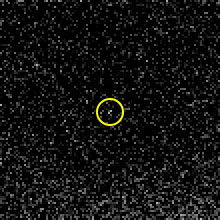Albioriks (księżyc)
 | |
| Planeta | |
|---|---|
| Odkrywca | |
| Data odkrycia | 9 listopada 2000[1] |
| Tymczasowe oznaczenie | S/2000 S 11 |
| Charakterystyka orbity | |
| Półoś wielka | 16 393 000 km[2] |
| Mimośród | 0,4797[2] |
| Okres obiegu | 783,46 d[2] |
| Nachylenie do ekliptyki | 34,060°[2] |
| Długość węzła wstępującego | 102,512°[2] |
| Argument perycentrum | 55,932°[2] |
| Anomalia średnia | 32,828°[2] |
| Własności fizyczne | |
| Średnica równikowa | 32 km[1] |
| Okres obrotu wokół własnej osi | |
| Albedo | 0,06[1] |
| Jasność obserwowana (z Ziemi) | 20,5m |
Albioriks (Saturn XXVI) – naturalny satelita Saturna, odkryty przez M.J. Holmana i T.B. Spahra w 2000 roku za pomocą teleskopu w Obserwatorium Whipple’a w Arizonie[1]. Jego nazwa pochodzi z mitologii celtyckiej, od jednego z głównych bogów galijskich – Albioriksa, utożsamianego z rzymskim Marsem[1].
Charakterystyka
Albioriks jest największym księżycem z grupy galijskiej księżyców nieregularnych, krąży po nachylonej orbicie o dużym mimośrodzie. Jego powierzchnia ma dwie różne barwy – czerwonawą, podobną do Erriapusa i Tarvosa, oraz obszar mniej czerwony. Podobieństwo orbit może wskazywać, że oba księżyce są fragmentami Albioriksa, wybitymi przez uderzenie, które utworzyło duży krater[4].
Jest on prawdopodobnie przechwyconą przez pole grawitacyjne Saturna planetoidą.
Zobacz też
- Chronologiczny wykaz odkryć planet, planet karłowatych i ich księżyców w Układzie Słonecznym
- Księżyce Saturna – zestawienie podstawowych danych
Przypisy
- ↑ a b c d e f Albiorix. [w:] Solar System Exploration [on-line]. NASA. [dostęp 2018-12-28]. (ang.).
- ↑ a b c d e f g Planetary Satellite Mean Orbital Parameters. Jet Propulsion Laboratory, 2013-08-23. [dostęp 2016-02-09]. (ang.).
- ↑ T. Denk, S. Mottola: Saturn's Irregular Moon Ymir. [w:] DPS meeting #44 [on-line]. American Astronomical Society, październik 2012. [dostęp 2016-02-09]. (ang.).
- ↑ T. Grav, J. Bauer. A deeper look at the colors of the saturnian irregular satellites. „Icarus”. 191 (1), s. 267-285, 2007-11-01. DOI: 10.1016/j.icarus.2007.04.020. (ang.).
Linki zewnętrzne
- Albiorix. [w:] Solar System Exploration [on-line]. NASA. [dostęp 2018-12-28]. (ang.).
Media użyte na tej stronie
This is a revised version of Solar_System_XXIX.png.
Saturn Cassini-Huygens (NASA)
Instrument: Imaging Science Subsystem - Narrow Angle
Saturn's peaceful beauty invites the Cassini spacecraft for a closer look in this natural color view, taken during the spacecraft's approach to the planet. By this point in the approach sequence, Saturn was large enough that two narrow angle camera images were required to capture an end-to-end view of the planet, its delicate rings and several of its icy moons. The composite is made entire from these two images.
Moons visible in this mosaic: Epimetheus (116 kilometers, 72 miles across), Pandora (84 kilometers, 52 miles across) and Mimas (398 kilometers, 247 miles across) at left of Saturn; Prometheus (102 kilometers, 63 miles across), Janus (181 kilometers, 113 miles across) and Enceladus (499 kilometers, 310 miles across) at right of Saturn.
The images were taken on May 7, 2004 from a distance of 28.2 million kilometers (17.6 million miles) from Saturn. The image scale is 169 kilometers (105 miles) per pixel. Moons in the image have been brightened for visibility.
The Cassini-Huygens mission is a cooperative project of NASA, the European Space Agency and the Italian Space Agency. The Jet Propulsion Laboratory, a division of the California Institute of Technology in Pasadena, manages the Cassini-Huygens mission for NASA's Office of Space Science, Washington, D.C. The Cassini orbiter and its two onboard cameras, were designed, developed and assembled at JPL. The imaging team is based at the Space Science Institute, Boulder, Colo.
For more information, about the Cassini-Huygens mission visit, http://saturn.jpl.nasa.gov and the Cassini imaging team home page, http://ciclops.org.Composite of ten W4 band (22 μm wavelength range) observations of Saturn's moon Albiorix by the Wide-Field Infrared Survey Explorer (WISE) from (2010-06-12 10:58:07 UT) to (2010-06-13 10:46:54 UT). These images were processed from archival WISE data provided by the IRSA.


